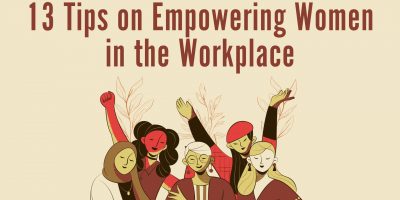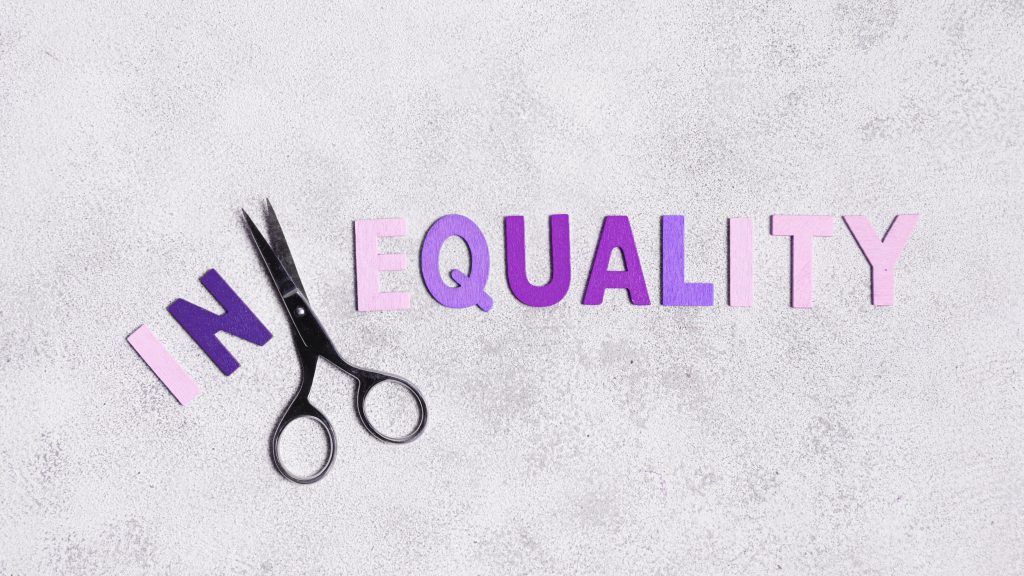
13 Tips on Empowering Women in the Workplace
From fostering inclusive environments to advocating for equal opportunities – elevate your organization’s commitment to gender equality with actionable advice.

The complete closure of the gender gap is projected to require 132 years.
According to the 2022 annual report by the World Economic Forum, with this progress rate and a global gender gap at 68.1%, women will need almost another century and a half before society equally values them. This devastating fact reinforces the need for female empowerment to raise societal awareness and drive real, tangible change.
One way to do so is by promoting women’s empowerment in the workplace.
This gives female employees the support and confidence to pursue their goals and receive equal work opportunities. At the same time, it creates strong leaders capable of influencing gender parity for current and future generations.
Right now, the situation is unfavorable toward the female employee. Lower wages, unfair treatment, and continual bias put them at a disadvantage in the workplace.
In fact, the Global Gender Gap report reveals that the labor market gender parity is at a low of 62.9%, with much higher unemployment rates within the female workforce.
The COVID-19 pandemic has disproportionately affected female employees, with many facing job losses, reduced work hours, and increased caregiving responsibilities.
Women, especially those in low-wage jobs and minority groups, have been forced to choose between their professional advancement and caring for their families, exacerbating pre-existing gender inequalities in the workplace.
The pandemic has highlighted the need for more support and flexibility for working women, including access to affordable childcare and paid family leave.
Thus, implementing proper means to empower our female collages and employees can be the turnaround to an otherwise gloomy scenario. With the same goal, Shortlister commemorates Women’s History Month as we explore the importance and best ways of empowering women in the workplace.
Female empowerment in the workplace can come in many forms.
Sticking to the basics, it can be about providing equal opportunities regardless of gender or creating a purposely safe and supportive environment where women can take on leadership roles and be respected for their contributions.
In fact, numerous studies have proven that empowering women in the workplace is essential for creating a diverse and inclusive culture.
Historically speaking, women were deprived of equal rights for far too long. Just over a century ago, ideas such as economic independence, equal education, or voting were unimaginable. Women were mainly caregivers and could not pursue other “male-dominated” societal roles.
With the rise of democracy and many equal rights movements later, most countries worldwide are changing their ways.
From the first female Supreme Court law practitioner and equal pay activist, Belva Ann Lockwood, the Suffragettes, and to Simone de Beauvoir or Angela Davis – countless women and men fought for equal human rights.
However, there’s still a long way to go.
A World Bank report reveals that, in 2022, 2.4 billion working-age women don’t have the same economic opportunities.
Namely, 86 countries have some form of job restriction for their female population, while 95 countries do not guarantee equal salaries for equal work. As a result, the global gap in the expected lifetime earnings between men and women amasses $172 trillion.
Moreover, statistics show that women still fall behind in leadership positions and barely make up a quarter of the world’s politicians, even though they tend to be better leaders.
There’s evident gender discrimination in the workplace, making this issue an indispensable part of the women’s empowerment movement and employers’ strategies for creating an inclusive work environment.

For every dollar a man makes, a woman makes 77 cents.
Unfortunately, this is just one factor of gender disparity in the workplace, and the problem goes beyond the wage gap.
On average, women enjoy only three-quarters of all men’s rights in the workplace.
Namely, a “Women, Business and the Law” report from 2019 measured workplace discrimination through eight indicators, from freedom of movement to acquiring a pension. The findings revealed that only six countries worldwide passed all criteria with full marks.
The U.S. was not one of them.
Women in the Workplace, an annual report by McKinsey, shows that for every 100 men that receive promotions, 87 women get the same opportunity. The promotion rate is even lower for women of color, at just 84 for every 100 men. The findings reveal that this is especially true in senior leadership positions, considering how only one in four C-suite leaders is female, and one in 20 is a woman of color.
An explanation for why this remains a problem well into the 21st century would be the bias and discrimination women face. Apart from the systematic obstructions to promotions and unequal wages, this also takes the form of microaggression, stereotypes, and sexism.
Women are still primarily seen as mothers and caregivers and less as providers and leaders.
One poll by Samsung U.K. and Ireland shows that they were three times more likely than men to be asked to make tea or coffee in the workplace and twice as likely to be asked about their children. Even more devastating was that they were often the target of sexist jokes in both informal and formal settings.
The poll also revealed that:
There are many things that companies can do to challenge the status quo, from educating employees to changing company policies. Ultimately, it all comes down to acknowledging, supporting, and empowering women in business.
There’s no single or right answer as to why female empowerment is important. The concept itself promotes women’s social, economic and political equality. It is the idea that women should have the same rights, opportunities, and resources as men.
In the work environment, however, it boils down to these three things: profitability, work culture, and potential.
McKinsey’s 2022 report reveals a shift in the workforce, as female leaders are quitting at the highest rates in years. Namely, for every woman who gets a leadership position promotion, two women directors decide to leave their firms. There are many reasons for this, but ultimately it comes down to seeking better opportunities.
The implications of such a shift for those not supporting gender diversity are harmful, especially during the talent war.
Likewise, employers who support women in leadership positions get much better results. Namely, the more they represent women, the better their performance is.
Research shows that companies with 30% female executives outperform those with fewer or no female representation in these roles. Additionally, they were more likely to have up to 25% above-average profitability.
Overcoming systemic obstacles in the workplace can lead to a more efficient workforce.
Studies have shown that diverse teams are more creative and innovative since they bring new insight, ideas, and different points of view to the table. This goes beyond gender and includes age, race, cultural diversity, and more.
Additionally, women are more likely to support others through mentorships.
Global study, “Women as Mentors: Does She or Doesn’t She”, reveals that 78% of women in senior roles have taken on the responsibility of a mentor. However, 63% never had one.
Company culture and profitability are interconnected.
Women are leaving working environments that are biased and discriminatory for ones that embrace their qualities.
Hence, a positive company culture goes a long way in helping companies maintain high retention levels and reduce turnover. According to Glassdoor’s 2020 Diversity Hiring Survey, for 76% of job seekers, a diverse workforce was an important factor in job evaluations.
At the same time, choosing and building the right culture type increases employee engagement. One study reveals that disengaged employees were 3.8 times more likely to cite organizational culture as their reason to quit.
The solution to this seems quite simple, seeing how much companies can gain from promoting women’s empowerment. Ultimately, all it takes is creating a job environment based on employee-friendly policies and shared values.

Empowering women in business usually results in female employees gaining more control over their careers and lives. Yet, only 15% of Fortune 500 CEOs are women.
Although it’s a record number, it doesn’t fare too well against the fact that women also make up almost half of the workforce.
After taking the role as the first woman CEO in The Hershey Company, Michele Buck immediately started working on creating an inclusive environment for her female colleagues. Her efforts led to Forbes naming the company the most female-friendly worldwide. Buck is currently working on increasing the female representation in the company to 50% and closing the gender pay gap for Hershey employees globally after she achieved pay equity in the U.S.
This is just one example of how companies are promoting women’s empowerment. Numerous companies and initiatives are making significant changes one step at a time.
While not everyone is on board, many large corporations understand why female empowerment is important and are doing their share.
For example, with female CEO Adena Friedman in charge, the stock exchange company NASDAQ offers access to Employee Resource Group (ERG) called WIN (Women in NASDAQ). The group provides support and professional development opportunities to the female workforce.
Conversely, Nestle does this by introducing the Gender Balance Acceleration Plan to increase women in senior positions. The company also offers at least 18 weeks of paid leave and a corporate mentoring program focusing primarily on women.
Reddit similarly empowers working mothers by offering them up to 26 weeks of paid leave, flexible schedules after giving birth, and $25,000 to support family planning efforts. The company also supports several ERGs like WomEng, a community for female engineers, Women-In-Product, and Women of Reddit.
Many companies empower women, especially multinational corporations, from Apple, Google, Adobe, and Disney, to name a few.
However, empowering women in the workplace is the responsibility of all employers equally, regardless of industry, type, or company size. Incorporating a culture of diversity, equity, and inclusion (DEI) should be just as crucial for small businesses to reduce turnover and attract top talent.
Efforts to support women go beyond the workplace and extend to state-wide or global levels.
For example, “The Women at Work Initiative” is one of seven by the International Labor Organization (ILO). Its goal is to understand better and address the slow progress and offer solutions and services to governments, workers, and employers.
ILO and UN Women have also created a handbook, titled “Addressing Violence and Harassment Against Women in the World of Work.” The publication collects worldwide examples, policies, and practices on this topic and provides guidance and practical information on preventing and responding to workplace violence and harassment.
Another example is the “Special Initiative on Women’s Empowerment.”
It’s a mutual effort of the B20 global task force of business leaders to respond to the impact COVID-19 had on women. Namely, according to the SHRM survey, 31% of respondents knew a woman who left the workplace during the pandemic because of caregiving responsibilities.
Of those affected by this, 27% of women confirmed that caregiving responsibilities hurt their careers, as opposed to 10% of men.
These are just some of the many examples of women’s initiatives in the workplace. However, depending on their primary mission, they can be summed up to support on:
Empowering women in the workplace is necessary to create a society that celebrates women and values their achievements.
From better comprehension of the problem to specific measures, here is how companies can support the women working for them.
Measuring and analyzing gender disparity in the workplace is the first step in securing fair treatment. By comparing data, companies can detect potential pay differences, career disadvantages, gender bias, etc. This data-driven approach and predictive analytics can help pinpoint which measures would most effectively address the inequity.
After identifying areas that need the most improvement, employers, with the help of HR and managers, should create strategies that reinforce equality among all employee levels.
After measuring the pain points of inequity, companies can empower women by setting up an inclusive workplace policy. A joint report by ILO, the EU, and UN Women on company policies and practices identifies five critical areas for employers to focus on:
The most recognizable factor for work-related gender disparity is the wage gap. As such, it should be one of the main priorities for employers.
A fair pay scheme and equal benefits can do more for women’s empowerment than any CEO’s speech, training, or campaign can. Being transparent about this can also help in the long run since it identifies inequities and opens improvement space.
Organizations should implement employee recognition initiatives and reward the success of their female employees just as much as their male counterparts. This means setting up policies on advancement opportunities that are fair, transparent, and bias-free.
Employers can also provide access to mental well-being support, flexibility in their work schedules, extended parental leave policy, and more. That way, they create an environment that gives equal opportunities for professional advancement, keeping in mind the main struggles of women in the workplace.
Women are still the primary caregivers.
According to one study published by the World Journal of Psychiatry, they comprise 81% of formal and informal caregivers. This is time-consuming and puts more pressure on the female workforce.
Companies can show their support by giving them paid leave and childcare benefits to tackle this issue. An equitable parental leave policy empowers both genders in family planning.
It allows them to feel confident about their decision and job security. Also, it takes the complexity out of returning to work for mothers, ensuring they have the time to care for their children properly.
According to McKinsey research, parents want flexible hours.
Giving women more control over their schedules could be a powerful tool to empower them.
Since female workers often face greater parental obligations, it can be challenging to adhere to a traditional 9-5. Thus, flexible schedules make it easier for them to balance their personal and professional obligations while remaining productive at work.

Right now, women have fewer career advancement opportunities than men, especially in leadership roles.
Employers should ensure that they are adequately represented in managerial and executive roles and allow them to make strategic choices. Increasing female presence in executive positions ensures their voices are heard, respected, and considered.
A Heidrick & Struggles’ “Creating a Culture of Mentorship“ survey reveals that for 30% of women, the mentoring relationship was extremely important, compared to 23% of men.
Training, mentorship, and sponsorship programs promote women’s empowerment by giving them the necessary skills and competencies for career growth. Such programs could provide a much-needed competitive edge and help employees move up the corporate ladder.
Additionally, they are an excellent way for employees to become more confident, speak up, and take risks.
Change starts at the top. So, when executives and managers don’t work on their inclusive leadership skills, discrimination is bound to happen. Contrary to this, inclusive leaders contribute to sustainable growth.
That’s why organizations should invest in structured support and training for managers and executives. That way, they can ensure everyone feels valued for their unique perspectives and contributions by creating a culture of respect, fairness, and acceptance.
Diversity, equity, and inclusion initiatives foster a more welcoming environment, promoting employees’ sense of belonging and acceptance. They can help companies gain a competitive advantage as they work to attract and retain the best talent.
Ultimately, DE&I initiatives benefit employers and employees as they promote a workplace that supports and encourages the growth and development of all individuals.
Incorporating all or most examples above will cultivate an inclusive company culture that welcomes diversity and promotes equal rights.
For women, that means a safe space to voice their opinions and concerns, assert their rights, and contribute to the organization’s decision-making processes. According to corporate diversity statistics, diverse teams make 87% better business decisions than individual decision-makers.
For companies, that means having a more assorted talent pool, resulting in more significant innovation and productivity.
After measuring and identifying the areas of inequality, regardless of employers’ approach to bridging the gender gap, they must monitor how it affects the workforce and whether it brings progress.
In addition to gathering and monitoring data, HR should issue regular surveys to uncover the biggest issues, unmet needs, and areas of improvement.
COVID-19 was an unforeseen challenge that affected the female workforce, especially working mothers.
Even before, women feared for their job safety and the impact a family could have on their career, according to a 2018 PwC survey. More than half responded that companies are not doing enough, and 31% believed gender could curb their professional progress.
At the time, there wasn’t much companies could do to predict the aftermath of the pandemic. However, post-pandemic, they should retain the lessons and recognize that challenges are still ahead. In the long run, awareness is the first step to actual change.
DE&I stands for diversity, equity, and inclusion.
Since tackling societal, racial, or gender injustices in reality comes down to the employers, they can implement DE&I initiatives in the workplace to ensure a better work environment for everyone, including women.
These measures help organizations meet their social or compliance goals while providing a safe and supportive space for everyone.
Regarding promoting women’s empowerment, DE&I initiatives increase security and support, even more so when companies tailor them to fit their employees’ needs.
As a workplace benefit, they benefit women and workers of all backgrounds. Ultimately, this leads to a healthier and more productive workforce. However, the key is to create a strategy that considers the specific employee characteristics and delivers solutions tailored to their needs.
Some examples of DE&I initiatives are:
The global pandemic exposed gender-based inequalities that were overlooked for far too long. Women were more affected by layoffs and had to decide between being full-time caregivers or employees.
Thus, female empowerment should not be undermined or overlooked if we want to undo the damage and reach gender equality sooner than the next century.
The future of women’s empowerment lies in focusing more on women’s rights and making better efforts to ensure that they are granted equal opportunities in all aspects of life, including the workplace.
At the same time, as technology advances, there is great potential for women with previously inaccessible opportunities.
In fact, this year’s theme for International Women’s Day is “DigitALL: Innovation and technology for gender equality.” Seeing how women face unique challenges in the workplace, technological advancements could help them through upskilling and reskilling.
That way, they can access sectors with growth potential for the future, like IoT, AI, or green economy.
By increasing female employees in these positions and contributing to their professional and economic empowerment, we could achieve a more resilient workforce that will improve the overall economy.

Empowering women in business is not about forcefully reaching a 50:50 gender balance. Instead, it’s about giving everyone equal opportunities to thrive in different spheres of life and removing the obstacles and biases women currently face in the workplace.
Even though the U.S. shows somewhat better results in gender disparity, the devastating reality is that, as a society, we are not doing enough. In fact, there’s a regression on this matter compared to just a few years back when the gender gap was set to close within 100 years.
There have been significant milestones toward gender parity in the past century. However, an equal female contribution is necessary to create profound economic and societal transformation.
Empowering women in the workplace is a good start. It ultimately creates a healthy work environment where employees and employers can prosper.
Content Writer at Shortlister
Browse our curated list of vendors to find the best solution for your needs.
Subscribe to our newsletter for the latest trends, expert tips, and workplace insights!

From fostering inclusive environments to advocating for equal opportunities – elevate your organization’s commitment to gender equality with actionable advice.

Discover the game-changing shift from a weight-focused worksite wellness model to a weight-inclusive approach, where health and well-being thrive beyond the scale.

Can leaders truly build resilient and trustworthy businesses by integrating ethical considerations into the fabric of their organization?

Unveil the latest women in leadership statistics and companies’ efforts to close the gender gap.
Used by most of the top employee benefits consultants in the US, Shortlister is where you can find, research and select HR and benefits vendors for your clients.
Shortlister helps you reach your ideal prospects. Claim your free account to control your message and receive employer, consultant and health plan leads.